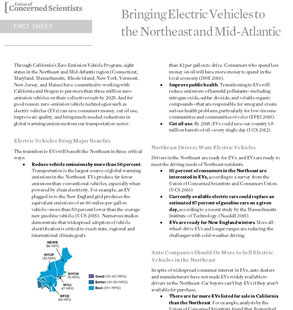Zero-emission vehicle technologies such as electric vehicles (EVs) can save consumers money, cut oil use, improve air quality, and bring much-needed reductions in global warming emissions from our transportation sector.
Through California’s Zero Emission Vehicle Program, eight states in the Northeast and Mid-Atlantic region (Connecticut, Maryland, Massachusetts, Rhode Island, New York, Vermont, New Jersey, and Maine) have committed to working with California and Oregon to put more than three million zero-emission vehicles on their collective roads by 2025. And for good reason: zero-emission vehicle technologies such as electric vehicles (EVs) can save consumers money, cut oil use, improve air quality, and bring much-needed reductions in global warming emissions from our transportation sector.
This transition will benefit the region by:
- Reducing vehicle emissions by more than 50%.
- Reducing average Northeast drivers’ fuel costs by hundreds of dollars per year.
- Improving public health by reducing harmful tailpipe pollution.
- Cutting oil use.
Drivers in the Northeast want electric vehicles (EVs) and for good reason:
- 55 percent of drivers in the Northeast are interested in EVs.
- Currently available electric cars could replace an estimated 87 percent of gasoline cars on a given day.
- EVs are ready for New England winters.
However, an analysis by the Union of Concerned Scientists has found that there are far more EVs listed for sale in California than in the Northeast.
- There are far more EVs listed for sale in California than the Northeast. Even when adjusted for relative car ownership, auto dealers in Boston had 90% fewer listings for EVs than auto dealers in the San Francisco-Oakland Bay Area.
- California auto dealers have twice as many EVs on the lot and available for test drives as dealers in the Northeast, according to a recent analysis by the Sierra Club.
Keeping the Northeast region on track to put over 2 million electric vehicles on the road will require improvements in the Zero-Emission Vehicle regulation.
Currently California’s ZEV regulation allows sales of battery-electric and fuel-cell EVs in California to count towards compliance in the Northeast. Automakers have therefore focused sales efforts on California, at the expense of Northeast consumers. This current exemption must expire at the end of 2017 as scheduled to ensure that Northeast consumers can choose from the full suite of plug-in vehicle technologies.
Further, because many EVs have already exceeded the mileage range set forth for 2025 and automakers receive more credits for longer0-range EVs, this will mean that automakers will need to sell fewer EVs to comply with the ZEV program. the ZEV program will require some adjustments to ensure we remain on track to achieve our goal of deploying over 3 million EVs by 2025.
The Zero-Emission Vehicle program remains a critical pillar of the Northeast strategy to achieve our climate goals, reduce oil use, save consumers money and reduce local air pollution. Northeast states should remain engaged with California regulators to ensure that this program remains strong through 2025.




